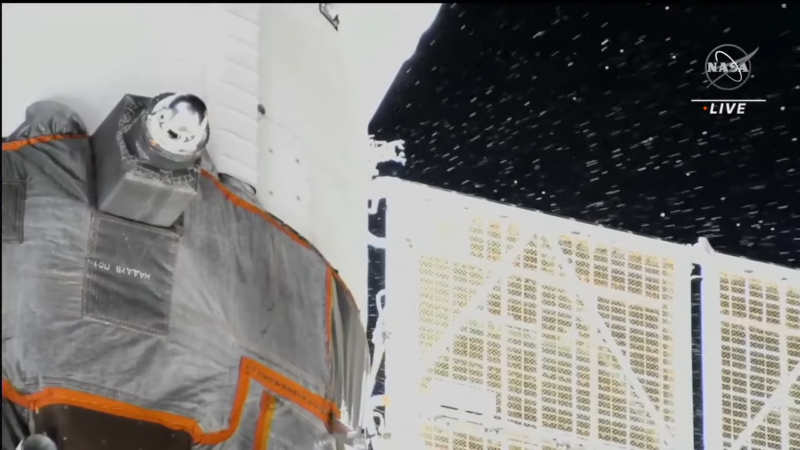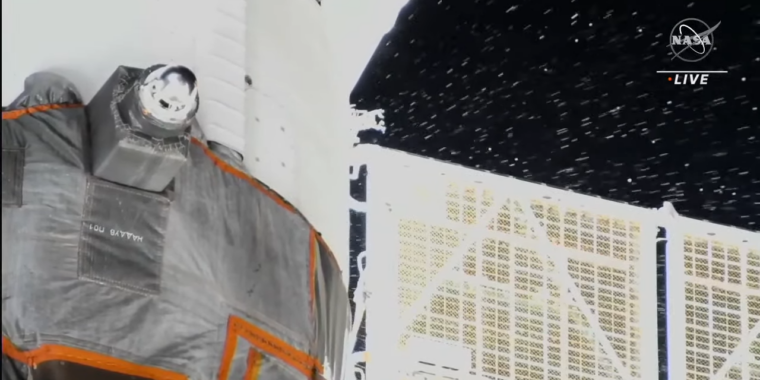
NASA TV
Four weeks ago, as two Russian cosmonauts were preparing for a spacewalk, a Soyuz spacecraft attached to the International Space Station began leaking uncontrollably.
The spacewalk was canceled and Russian and American aerospace engineers have since analyzed the source of the leak and its implications for future travel to and from the large laboratory in low Earth orbit. They have now deduced that a micrometeoroid or small piece of orbital debris hit the Soyuz spacecraft’s external cooling loop, causing all of the coolant to spill into space, and have drawn up a recovery plan.
While there were no immediate threats to the seven astronauts aboard the space station, there was the not insignificant question of how the three people who were orbiting the Earth aboard this Soyuz MS-22 spacecraft – cosmonauts Sergey Prokopyev and Dmitri Petelin and NASA’s Frank Rubio – would come home later.
Now we finally have an answer. On Wednesday, officials from NASA and Russia’s state space agency Roscosmos said a replacement Soyuz spacecraft will launch to and autonomously dock at the station next month. The crew who would have flown in the damaged Soyuz MS-22 vehicle will instead fly home in this Soyuz MS-23 spacecraft later in 2023. The leaky Soyuz MS-22 vehicle will return to Earth autonomously, without a crew, likely in March.
The executive director for human spaceflight at Roscosmos, Sergei Krikalev, said on a conference call with reporters on Wednesday that he is certain the cooling system was damaged by an object about 1mm in diameter. This assessment was based on high-resolution images of the damage site and ground testing to simulate the problem. It is impossible to determine whether this was a small meteor fragment or one of countless pieces of space debris whizzing into low Earth orbit.
Russian officials believe the Soyuz MS-22 is still flyable in an emergency. However, without an efficient way to radiate heat during a six-hour return to Earth, the spacecraft’s interior could overheat. This could damage the flight computers used to set an accurate return trajectory and endanger the crew. Krikalev said the temperature in Soyuz MS-22 could reach the low 40s Celsius (105-110 °F) during its return to Earth. Concerns about the health of the crew members in such a scenario are both about humidity and temperature.
Russian and NASA officials have been looking at contingency plans in case of a space station emergency between now and when Soyuz MS-23 arrives in February. In such an event, one or more crew members of the MS-22 could find a safe haven and possibly return to Earth in the Crew-5 Dragon currently attached to the space station. That vehicle nominally carries four astronauts, but it could carry more people home.
“SpaceX is extremely responsive,” said Joel Montalbano, program manager for NASA’s International Space Station. “But everything this is for emergencies only, only if we need to evacuate the ISS. We are always looking at what we can do to ensure the safety of the crew. Nominally, the plan is that when Crew-5 come home, they come home with four people.”
The crew of Soyuz MS-22 launched to the space station in September. They were due to return to Earth in March, before the dramatic coolant leak. Now their mission will be extended for “several” months, Krikalev said. It’s possible that the three astronauts, including NASA’s Frank Rubio, may not return to Earth until September 2023, when Soyuz MS-24 is ready to launch the next Russian crew rotation into orbit. This likely means that the crew scheduled to launch this spring, Russia’s Oleg Kononenko and Nikolai Chub and NASA’s Loral O’Hara, will wait until this fall to carry out their mission.
“The great thing about our crews is that they are willing to help with anything we ask,” Montalbano said. “They will stay until a September launch date if needed. The crews are excited to be in space.”
Since the coolant leak, Russian and American engineers and managers have worked together smoothly, Montalbano said. It’s remarkable that NASA and Roscosmos still work exceptionally well together when it comes to ISS operations, given everything that’s happened since the Russian invasion of Ukraine. This bodes well for the continuation of the space station partnership for the remainder of the 2020s, despite hostilities on Earth.

